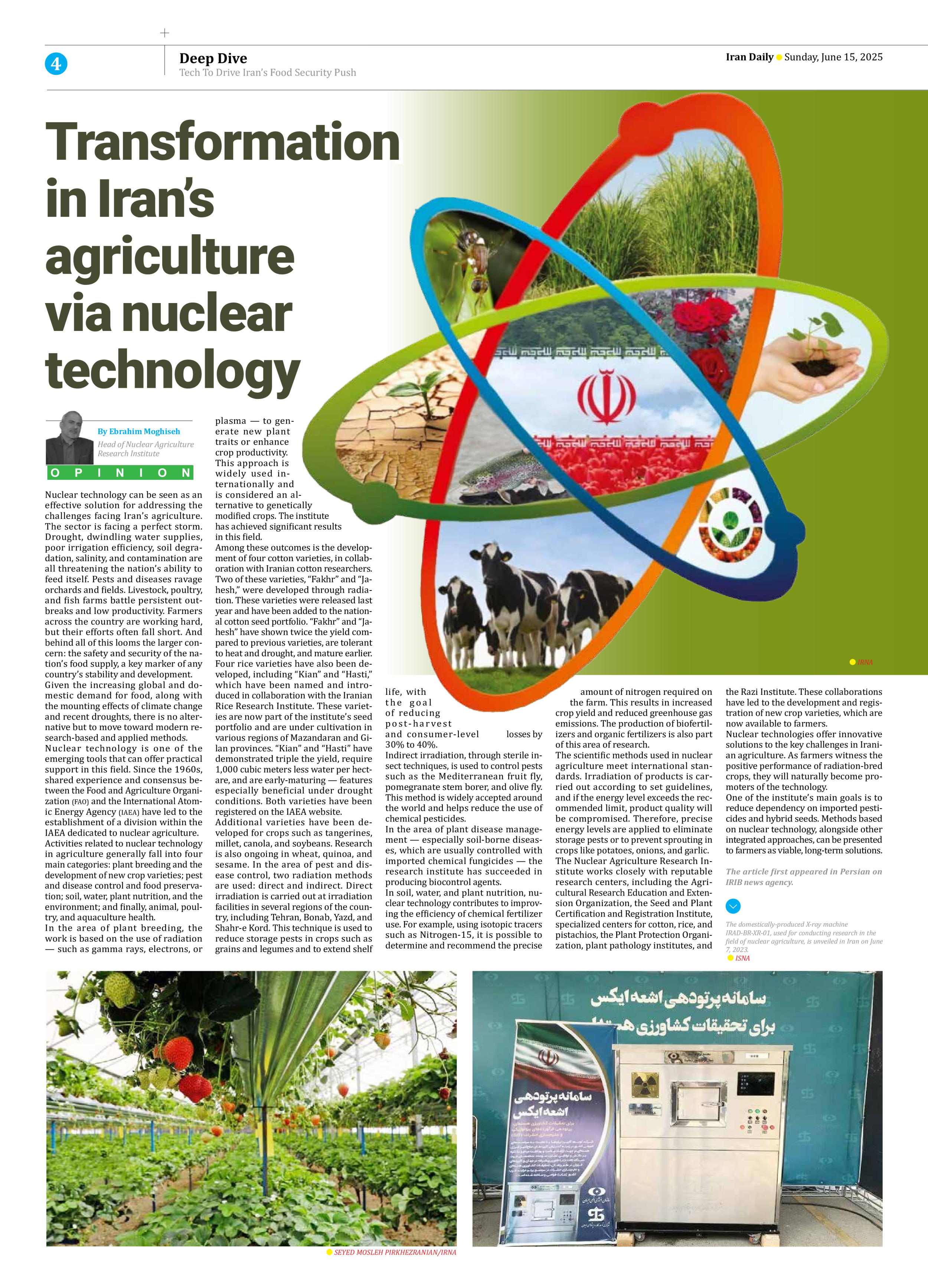
Transformation in Iran’s agriculture via nuclear technology
By Ebrahim Moghiseh
Head of Nuclear Agriculture Research Institute
Nuclear technology can be seen as an effective solution for addressing the challenges facing Iran’s agriculture. The sector is facing a perfect storm. Drought, dwindling water supplies, poor irrigation efficiency, soil degradation, salinity, and contamination are all threatening the nation’s ability to feed itself. Pests and diseases ravage orchards and fields. Livestock, poultry, and fish farms battle persistent outbreaks and low productivity. Farmers across the country are working hard, but their efforts often fall short. And behind all of this looms the larger concern: the safety and security of the nation’s food supply, a key marker of any country’s stability and development.
Given the increasing global and domestic demand for food, along with the mounting effects of climate change and recent droughts, there is no alternative but to move toward modern research-based and applied methods.
Nuclear technology is one of the emerging tools that can offer practical support in this field. Since the 1960s, shared experience and consensus between the Food and Agriculture Organization (FAO) and the International Atomic Energy Agency (IAEA) have led to the establishment of a division within the IAEA dedicated to nuclear agriculture.
Activities related to nuclear technology in agriculture generally fall into four main categories: plant breeding and the development of new crop varieties; pest and disease control and food preservation; soil, water, plant nutrition, and the environment; and finally, animal, poultry, and aquaculture health.
In the area of plant breeding, the work is based on the use of radiation — such as gamma rays, electrons, or plasma — to generate new plant traits or enhance crop productivity. This approach is widely used internationally and is considered an alternative to genetically modified crops. The institute has achieved significant results in this field.
Among these outcomes is the development of four cotton varieties, in collaboration with Iranian cotton researchers. Two of these varieties, “Fakhr” and “Jahesh,” were developed through radiation. These varieties were released last year and have been added to the national cotton seed portfolio. “Fakhr” and “Jahesh” have shown twice the yield compared to previous varieties, are tolerant to heat and drought, and mature earlier.
Four rice varieties have also been developed, including “Kian” and “Hasti,” which have been named and introduced in collaboration with the Iranian Rice Research Institute. These varieties are now part of the institute’s seed portfolio and are under cultivation in various regions of Mazandaran and Gilan provinces. “Kian” and “Hasti” have demonstrated triple the yield, require 1,000 cubic meters less water per hectare, and are early-maturing — features especially beneficial under drought conditions. Both varieties have been registered on the IAEA website.
Additional varieties have been developed for crops such as tangerines, millet, canola, and soybeans. Research is also ongoing in wheat, quinoa, and sesame. In the area of pest and disease control, two radiation methods are used: direct and indirect. Direct irradiation is carried out at irradiation facilities in several regions of the country, including Tehran, Bonab, Yazd, and Shahr-e Kord. This technique is used to reduce storage pests in crops such as grains and legumes and to extend shelf life, with the goal of reducing post-harvest and consumer-level losses by 30% to 40%.
Indirect irradiation, through sterile insect techniques, is used to control pests such as the Mediterranean fruit fly, pomegranate stem borer, and olive fly. This method is widely accepted around the world and helps reduce the use of chemical pesticides.
In the area of plant disease management — especially soil-borne diseases, which are usually controlled with imported chemical fungicides — the research institute has succeeded in producing biocontrol agents.
In soil, water, and plant nutrition, nuclear technology contributes to improving the efficiency of chemical fertilizer use. For example, using isotopic tracers such as Nitrogen-15, it is possible to determine and recommend the precise amount of nitrogen required on the farm. This results in increased crop yield and reduced greenhouse gas emissions. The production of biofertilizers and organic fertilizers is also part of this area of research.
The scientific methods used in nuclear agriculture meet international standards. Irradiation of products is carried out according to set guidelines, and if the energy level exceeds the recommended limit, product quality will be compromised. Therefore, precise energy levels are applied to eliminate storage pests or to prevent sprouting in crops like potatoes, onions, and garlic.
The Nuclear Agriculture Research Institute works closely with reputable research centers, including the Agricultural Research Education and Extension Organization, the Seed and Plant Certification and Registration Institute, specialized centers for cotton, rice, and pistachios, the Plant Protection Organization, plant pathology institutes, and the Razi Institute. These collaborations have led to the development and registration of new crop varieties, which are now available to farmers.
Nuclear technologies offer innovative solutions to the key challenges in Iranian agriculture. As farmers witness the positive performance of radiation-bred crops, they will naturally become promoters of the technology.
One of the institute’s main goals is to reduce dependency on imported pesticides and hybrid seeds. Methods based on nuclear technology, alongside other integrated approaches, can be presented to farmers as viable, long-term solutions.
The article first appeared in Persian on IRIB news agency.







